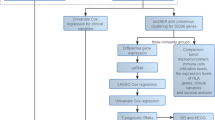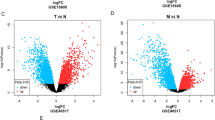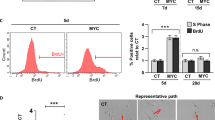Abstract
Amplification and overexpression of the c-myc gene have been associated with neoplastic transformation in a plethora of malignant tumours. We applied interphase fluorescence in situ hybridization (FISH) with a locus-specific probe for the c-myc gene (8q24) in combination with a corresponding chromosome 8 α-satellite probe to evaluate genetic alterations in 8 primary melanomas and 33 advanced melanomas and compared it to 12 melanocytic nevi, 7 safety margins and 2 cases of normal skin. Additionally, in metaphase spreads of 7 melanoma cell lines a whole chromosome 8 paint probe was used. We investigated the functionality of the c-myc gene by detecting c-myc RNA expression with RT-PCR and c-myc protein by immunohistochemistry. 4/8 primary melanomas and 11/33 melanoma metastases showed additional c-myc signals relative to the centromere of chromosome 8 copy number. None of the nevi, safety margins or normal skin samples demonstrated this gain. In 2/7 melanoma cell lines (C32 and WM 266–4) isochromosome 8q formation with a relative gain of c-myc copies and a loss of 8p was observed. The highest c-myc gene expression compared to GAPDH was found in melanoma metastases (17.5%). Nevi (6.6%) and primary melanomas (5.0%) expressed the c-myc gene on a lower level. 72.7% of the patients with c-myc extra copies had visceral melanoma metastases (UICC IV), patients without c-myc gain in 35.0% only. The collective with additional c-myc copies also expressed the gene on a significantly higher level. These results indicate that a c-myc gain in relation to the centromere 8 copy number might be associated with advanced cutaneous melanoma. © 2001 Cancer Research Campaign
Similar content being viewed by others
Article PDF
Change history
16 November 2011
This paper was modified 12 months after initial publication to switch to Creative Commons licence terms, as noted at publication
References
Balch CM, Soong SJ, Shaw HM and Milton GW (1985) An analysis of prognostic factors in 4000 patients with cutaneous melanoma. Balch CM, Milton GW, Shaw HM, Soong SJ (eds) Cutaneous melanoma. Clinical management and treatment results worldwide, Lippincott: Philadelphia. pp. 321–352
Bar-Am I, Mor O, Yeger H, Shiloh Y and Avivi L (1992) Detection of amplified DNA sequences in human tumor cell lines by fluorescence in situ hybridization. Gene Chromosome Canc 4: 314–320
Bergman R, Lurie M, Kerner H, Kilim S and Friedman-Birnbaum R (1997) Mode of c-myc protein expression in Spitz nevi, common melanocytic nevi and malignant melanomas. J Cutan Pathol 24: 219–222
Berns EM, Klijn JG, van Putten WL, van Staveren IL, Portengen H and Foekens JA (1992) C-myc amplification is a better prognostic factor than HER 2/ neu amplification in primary breast cancer. Cancer Res 52: 1107–1113
Boni R, Bantschapp O, Muller B and Burg G (1998) C-myc is not useful as prognostic immunohistochemical marker in cutaneous melanoma. Dermatology 196: 288–291
Chin L, Liégeois N, DePinho RA and Schreiber-Agus N (1996) Functional interactions among members of the myc superfamily and potential relevance to cutaneous growth and development. J Invest Dermatol Symp Proc 1: 128–135
Citro G, D'Agnano I, Leonetti C, Perini R, Bucci B, Zon G, Calabretta B and Zupi G (1998) C-myc antisense oligodeoxynucleotides enhance the efficacy of cisplatin in melanoma chemotherapy in vitro and in nude mice. Cancer Res 58: 283–289
Cole MD (1986) The myc oncogene: its role in transformation and differentiation. Annu Rev Genet 20: 361–384
Collins S and Groudine M (1982) Amplification of endogenous myc-related DNA sequences in a human myeloid leukaemia cell line. Nature 298: 679–681
Cremer T, Landegent J and Bruckner A (1986) Detection of chromosome aberrations in the human interphase nucleus by visualization of specific target DNAs with radioactive in situ hybridization techniques: diagnosis of trisomy 18 with probe L.1.84. Hum Genet 74: 346–352
Garte SJ (1993) The c-myc oncogene in tumor progression. Crit Rev Oncog 4: 435–449
Ghazvini S, Char DH, Kroll S, Waldman FM and Pinkel D (1996) Comparative genomic hybridization analysis of archival formalin fixed paraffin embedded uveal melanomas. Cancer Genet Cytogen 90: 95–101
Grover R, Ross DA, Richman PI, Robinson B and Wilson GD (1996) C-myc oncogene expression in human melanoma and its relationship with tumour antigenicity. Eur J Surg Oncol 22: 342–346
Hopman AH, Voorter CE and Ramaekers FC (1994) Detection of genomic changes in cancer by in situ hybridization. Mol Biol Rep 19: 31–44
Horsman DE, Sroka H, Rootman J and White VA (1990) Monosomy 3 and isochromosome 8q in uveal melanoma. Cancer Genet Cytogen 45: 249–253
Jenkins RB, Qian J, Lieber MM and Bostwick DG (1997) Detection of c-myc oncogene amplification and chromosomal anomalies in metastatic prostatic carcinoma by Fluorescence in Situ Hybridization. Cancer Res 57: 524–531
Kakisako K, Miyahara M, Uchino S, Adachi Y and Kitano S (1998) Prognostic significance of c-myc mRNA expression assessed by semi-quantitative RT-PCR in patients with colorectal cancer. Oncol Rep 5: 441–445
Koh HK (1991) Cutaneous melanoma. N Engl J Med 325: 171–182
Lichter P, Boyle AL, Cremer T and Ward DC (1991) Analysis of genes and chromosomes by nonisotopic in situ hybridization. GATA 8: 24–35
Little CD, Nau MM, Carney DN, Gazdar AF and Minna JD (1983) Amplification and expression of the c-myc oncogene in human lung cancer cell lines. Nature 306: 194–196
Masramon L, Arribas R, Tortola S, Perucho M and Peinado MA (1998) Moderate amplifications of the c-myc gene correlate with molecular and clinicopathological parameters in colorectal cancer. Brit J Cancer 99: 2349–2356
Meichle A, Philipp A and Eilers M (1992) The functions of Myc proteins. Biochim Biophys Acta 1114: 129–146
Osanto S, Jansen R and Vloemans M (1992) Downmodulation of c-myc expression by interferon γ and tumour necrosis factor α precedes growth arrest in human melanoma cells. Eur J Cancer 28: 1622–1627
Ozisik YY, Meloni AM, Altungoz O, Peier A, Karakousis C, Leong SPL and Sandberg AA (1994) Cytogenetic findings in 21 malignant melanomas. Cancer Genet Cytogen 77: 69–73
Pedersen MI, Bennett JW and Wang N (1986) Nonrandom chromosome structural aberrations and oncogene loci in human malignant melanoma. Cancer Genet Cytogen 20: 11–17
Pinkel D, Straume T and Gray JW (1986) Cytogenetic analysis using quantitative, high sensitivity, fluorescence hybridization. Proc Natl Acad Sci 83: 2934–2938
Prescher G, Bornfeld N and Becher R (1990) Nonrandom chromosomal abnormalities in primary uveal melanoma. J Natl Cancer I 82: 1765–1769
Robinson JK, Rigel DS and Amonette RA (1997) Trends in sun exposure knowledge, attitudes, and behaviors: 1986–1996. J Am Acad Dermatol 37: 179–186
Ross DA and Wilson GD (1998) Expression of c-myc oncoprotein represents a new prognostic marker in cutaneous melanoma. Brit J Surg 85: 46–51
Schlagbauer-Wadl H, Griffioen M and von Elsas A (1999) Influence of Increased c-Myc Expression on the Growth Characteristics of Human Melanoma. J Invest Dermatol 112: 332–336
Sisley K, Rennie IG, Parsons MA, Jacques R, Hammond DW, Bell SM, Potter AM and Rees RC (1997) Abnormalities of chromosomes 3 and 8 in posterior uveal melanoma correlate with prognosis. Gene Chromosome Canc 19: 22–28
Taub R, Kirsch I, Morton C, Lenoir G, Swan D, Tronick S, Aaronon S and Leder P (1982) Translocation of the c-myc gene into the immunoglobulin heavy chain locus in human Burkitt lymphoma and murine plasmacytoma cells. Proc Nat Acad Sci 79: 7837–7841
Thompson EB (1998) The many roles of c-myc in apoptosis. Annu Rev Physiol 60: 575–600
Visscher DW, Wallis T, Awussah S, Mohamed A and Crissman JD (1997) Evaluation of myc and chromosome 8 copy number in breast carcinoma by interphase cytogenetics. Gene Chromosome Canc 18: 1–7
Vogelstein B and Kinzler KW (1993) The multistep nature of cancer. Trends Genet 9: 138–141
Author information
Authors and Affiliations
Rights and permissions
From twelve months after its original publication, this work is licensed under the Creative Commons Attribution-NonCommercial-Share Alike 3.0 Unported License. To view a copy of this license, visit http://creativecommons.org/licenses/by-nc-sa/3.0/
About this article
Cite this article
Kraehn, G., Utikal, J., Udart, M. et al. Extra c-myc oncogene copies in high risk cutaneous malignant melanoma and melanoma metastases. Br J Cancer 84, 72–79 (2001). https://doi.org/10.1054/bjoc.2000.1535
Received:
Revised:
Accepted:
Published:
Issue date:
DOI: https://doi.org/10.1054/bjoc.2000.1535
Keywords
This article is cited by
-
CircMYC Regulates Glycolysis and Cell Proliferation in Melanoma
Cell Biochemistry and Biophysics (2020)
-
Cross-species genomic landscape comparison of human mucosal melanoma with canine oral and equine melanoma
Nature Communications (2019)
-
A geometric approach to characterize the functional identity of single cells
Nature Communications (2018)
-
Discovery of potential biomarkers in human melanoma cells with different metastatic potential by metabolic and lipidomic profiling
Scientific Reports (2017)
-
Melanocytic nevi and melanoma: unraveling a complex relationship
Oncogene (2017)



